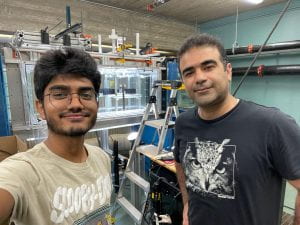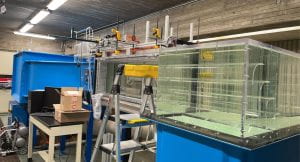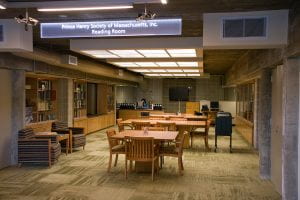Research in Mechanical Engineering
Development of a Thermoplastic Polymer Electrolyte-based Structural Supercapacitor
By Payton Parker
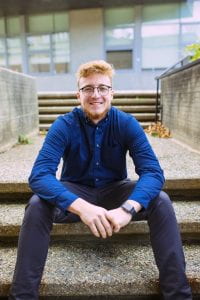
Portrait of Payton Parker
Introduction
Through the continually evolving world of energy usage, new ways to store energy are becoming increasingly important. For instance, in space technology, finding new ways to store energy in lighter and smaller packages is highly desirable. If weight can be reduced and the amount of stored power can be increased, the space mission durations can be lengthened significantly. To do so, devices called structural supercapacitors were built1–4. These devices can store electrical energy while being able to support a load. These two properties allow components which originally would be used solely for structural support to also have energy storage capabilities (Figure 1 5). Previous attempts at creating structural supercapacitors use an electrolyte matrix imbedded with carbon fibers functioning as both reinforcement and electrodes. The electrolyte matrix consisted of a resin mixed with ionic liquid. This mixture creates what is called a bi-continuous electrolyte. This complete separation in the electrolyte substantially limits the electrochemical and mechanical performance of the supercapacitor device6–8.
Dr. Caiwei Shen‘s research group has recently developed a new polymer electrolyte to use in the structural supercapacitor that has much better electrical performance and mechanical properties9. The key feature of this electrolyte is that it is a thermoplastic polymer-based single-phase electrolyte made using melt processing which has never been done before. This melt processing allows for increased ion transport and higher strength of the electrolyte matrix and potentially better performance of the structural supercapacitor devices.
In this project, we are proposing using this same polymer electrolyte in conjunction with carbon fiber fabric to construct new structural supercapacitor devices. The goal is to further improve the electrical and mechanical performance of the supercapacitor. To do this, we will (1) develop a new method for the manufacturing of the devices, and (2) optimize the composition of the electrolyte matrix.
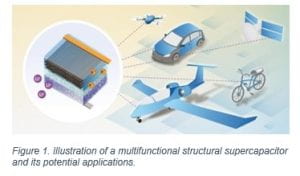
Methods
-
- Injection Molding Operation
An A&B Plastics AB-100 injection molder was used for all injection molded samples. This machine uses a pneumatic ram to force the melted material into the mold and must be connected to a compressor. To complete a “shot” (filling the cavity of the mold with molten plastic), the desired temperature of the chamber was set using the PID interface and the pneumatic ram pressure was adjusted using the built-in pressure regulator. At this point, a preheated mold was aligned under injector nozzle. Once the chamber temperature reached its target value, the ram was actuated using a lever filling the mold. After injection, the mold was removed and set aside for cooling. The part was then removed from the mold after a set amount of time.
- DSC Sample Preparation
Sample preparation for differential scanning calorimetry (DSC) was done in an M-Braun Uni-Lab Pro SP glove box. These samples were around 10 mg each and were tested using a TA Instruments DSC machine.
Results
-
- Optimized Injection Molding Procedure
The goal in optimizing the injection molding procedure was to find the smallest sample thickness achievable. This is important due to relation between electrolyte thickness and capacitance. The thinner the sample, the thinner the final thickness of the full device, which in turn improves capacitive behavior. The mold shown in figure 1 was designed and machined for this purpose. It features an adjustable insert that can be shimmed to change the depth of the mold cavity from 0.040” to 0.000”. The mold can also be disassembled quickly for cleaning in-between material compositions. 6061 aluminum was chosen as the primary material due to its high thermal conductivity and machinability, however the insert portion was machined from stainless steel. This was done to reduce the chance of the insert becoming seized in place.
Insert mold design
Using this adjustable mold, a set of experiments was designed to determine the best injection parameters for polyethylene terephthalate (PET). PET was chosen for these tests as it was the preferred material used for the matrix portion of the polymer electrolyte. Using the typical design of experiments layout made for multifunctional optimization, an initial set of parameters were established and used a basis for testing. Four separate tests were then done, varying each parameter one at a time. The characteristics of each result were carefully noted on for analysis at the end of each test set. In the following tables, each row highlighted in green represents the best result for the given experimental set. Characteristics such as clarity and ease of molding were the main forms evaluation.
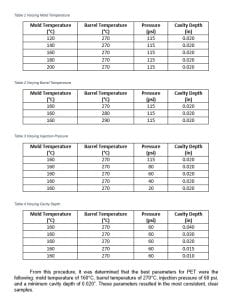
From this procedure, it was determined that the best parameters for PET were the following: mold temperature of 160°C, barrel temperature of 270°C, injection pressure of 60 psi, and a minimum cavity depth of 0.020”. These parameters resulted in the most consistent, clear samples.
- DSC Results
Differential scanning calorimetry was used to characterize two different polymer electrolyte materials. The first of which was PET+20%LiTSFI shown in figure 2. From the figure, it can be seen that the melting point is located around 234°C. The second was PLA+20%LiTSFI shown in the following figure.
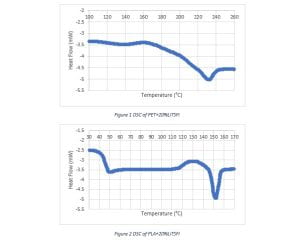
Discussion
Throughout this research project, many impactful discoveries were made. Most importantly a basis for injecting solid polymer electrolyte samples was established. Now the only step needed for injecting different compositions of electrolytes (changing the total lithium salt to polymer matrix ratio) was a DSC test to find the melting point of the specific composition. The other parameters could then be adjusted based on this temperature. On top of this, the DSC tests revealed that the PLA based electrolyte has a more definite glass transition point, around 50°C. This means even in a mostly solid phase, the PLA+20%LiTSFI begins to flow at low temperatures. This characteristic may be instrumental when attempting to impregnate weaved carbon fibers in future work.
It was lastly discovered that humidity plays a major role in the injection molding process. The ambient environment where the injection molding was done tended to have high humidity levels between 50-70%. It is well known that water content can significantly impact injection molding, so every precaution was taken including drying the material before injection, sealing the injection molding barrel when not in use, and preheating the barrel before injection. Unfortunately, these attempts only had a small impact on the results. Many of the samples were still dark in color due to water that was absorbed by the injection material. For this reason, a senior design team was sponsored in the mechanical engineering department to solve this humidity control issue.
References
- Xu, Y., Lu, W., Xu, G. & Chou, T. W. Structural supercapacitor composites: A review. Compos. Sci. Technol. 204, 108636 (2021). DOI:10.1016/j.compscitech.2020.108636
- Snyder, J. F., Gienger, E. B. & Wetzel, E. D. Performance metrics for structural composites with electrochemical multifunctionality. J. Compos. Mater. 49, 1835–1848 (2015). DOI:10.1177/0021998314568167
- Reece, R., Lekakou, C. & Smith, P. A. A structural supercapacitor based on activated carbon fabric and a solid electrolyte. Mater. Sci. Technol. (United Kingdom) 35, 368–375 (2019). DOI:10.1080/02670836.2018.1560536
- Shirshova, N., Qian, H., Houllé, M., Steinke, J. H. G. G., Kucernak, A. R. J. J., Fontana, Q. P. V. V, Greenhalgh, E. S., Bismarck, A. & Shaffer, M. S. P. P. Multifunctional structural energy storage composite supercapacitors. Faraday Discuss. 172, 81–103 (2014). DOI:10.1039/c4fd00055b
- Structural supercapacitor illustration. https://scitechdaily.com/big-breakthrough-for-massless-energy-storage-structural-battery-that-performs-10x-better-than-all-previous-versions/
- Shirshova, N., Bismarck, A., Carreyette, S., Fontana, Q. P. V., Greenhalgh, E. S., Jacobsson, P., Johansson, P., Marczewski, M. J., Kalinka, G., Kucernak, A. R. J., Scheers, J., Shaffer, M. S. P., Steinke, J. H. G. & Wienrich, M. Structural supercapacitor electrolytes based on bicontinuous ionic liquid-epoxy resin systems. J. Mater. Chem. A 1, 15300–15309 (2013). DOI:10.1039/c3ta13163g
- Tu, V., Asp, L. E., Shirshova, N., Larsson, F., Runesson, K. & Jänicke, R. Performance of bicontinuous structural electrolytes. Multifunct. Mater. 3, 025001 (2020). DOI:10.1088/2399-7532/ab8d9b
- Greenhalgh, E. S., Ankersen, J., Asp, L. E., Bismarck, A., Fontana, Q., Houlle, M., Kalinka, G., Kucernak, A., Mistry, M., Nguyen, S., Qian, H., Shaffer, M., Shirshova, N., Steinke, J. & Wienrich, M. Mechanical, electrical and microstructural characterisation of multifunctional structural power composites. J. Compos. Mater. 49, 1823–1834 (2015). DOI:10.1177/0021998314554125
- Joyal, N., Chang, Y.-C., Shonar, M., Chalivendra, V. & Shen, C. Solid polymer electrolytes with hydrates for structural supercapacitors. J. Energy Storage Accepted (2022).
- Anjum, N., Grota, M., Li, D. & Shen, C. Laminate composite-based highly durable and flexible supercapacitors for wearable energy storage. J. Energy Storage 29, 101460 (2020). DOI:10.1016/j.est.2020.101460



